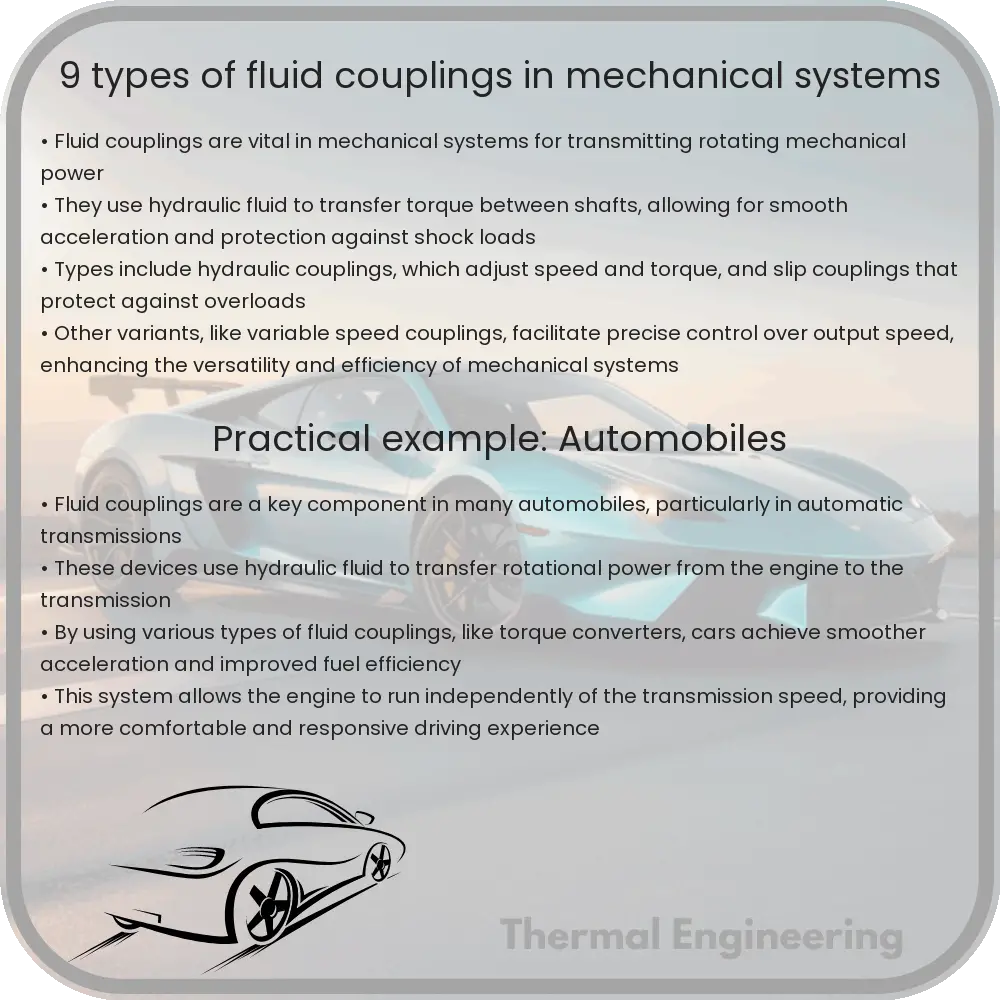Detailed exploration of nine types of fluid couplings, highlighting their roles in transferring torque and enhancing mechanical system efficiency.

Understanding Fluid Couplings: 9 Types in Mechanical Systems
Fluid couplings are fundamental components used extensively in mechanical engineering to transmit rotating mechanical power. They use a fluid to create a hydrodynamic connection which allows for the transfer of torque between the shafts. This article explores nine common types of fluid couplings used in various mechanical systems, significantly enhancing efficiency and control.
1. Hydraulic Torque Converter
A hydraulic torque converter is a type of fluid coupling that adds a variable aspect to torque conversion, making it ideal for automotive transmissions. This converter not only transmits power but also provides torque multiplication at low speeds, improving the vehicle’s acceleration.
2. Fluid Coupling
Often referred to simply as a “fluid coupling,” this basic type relies on two sets of vanes, one connected to the input and the other to the output shaft. It uses hydraulic oil to transmit power and provides a smooth start with reduced shock loads in power transmission systems.
3. Constant-fill Fluid Coupling
The constant-fill fluid coupling maintains a constant volume of fluid within the system. It is widely used in applications requiring stable operation and a predictable torque response, such as in conveyor systems and industrial processing equipment.
4. Variable Speed Fluid Coupling
This type allows the adjustment of torque and speed by varying the amount of hydraulic fluid or by changing the geometry of the passage through which the fluid moves. Variable speed fluid couplings are essential in applications requiring speed control and load variation, commonly found in fans and blowers.
5. Delayed Fill Fluid Coupling
In delayed fill fluid couplings, the chamber is initially empty, and fills gradually during operation. This design facilitates a controlled start-up by initially reducing torque, which can be critical in reducing mechanical stresses and energy usage in heavy machinery startups.
6. Slip Type Fluid Coupling
The slip type is designed to allow a certain amount of slip between input and output speeds, permanently or under specific conditions, providing a cushioning effect to reduce mechanical shocks and system stresses.
7. Lock-up Fluid Coupling
This variant incorporates a mechanical lock-up arrangement that can bypass the fluid coupling under certain operating conditions, directly connecting the input to the output. Lock-up fluid couplings are advantageous in applications where efficiency is critical at high speeds.
8. Hybrid Fluid Coupling
Hybrid fluid couplings combine the features of fluid couplings with other coupling types, like electromagnetic or mechanical clutches, to enhance functionality and adaptability across a broader range of operational conditions.
9. Pump and Motor Couplings
These are specialized fluid couplings where one part acts as a pump and the other as a motor. This type is particularly useful in complex hydraulic machinery and systems requiring variable torque and speed adjustments, such as in aerospace and heavy industry applications.
Fluid couplings are pivotal in modern engineering, providing a versatile and reliable method for managing torque and protecting mechanical systems. By understanding the distinct types and their specific applications, engineers can select the perfect fluid coupling type that best fits the operational and efficiency needs of their projects.